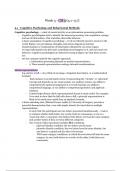Class notes
PSYB55 Chapter 3 notes - UTSC
- Course
- PSYB55H3 (PSYB55)
- Institution
- University Of Toronto (U Of T )
Detailed notes for Gazzaniga, M. S., Ivry, R. B., & Mangun, G. R. (2019). Cognitive Neuroscience: The Biology of the Mind. W. W. Norton.
[Show more]



